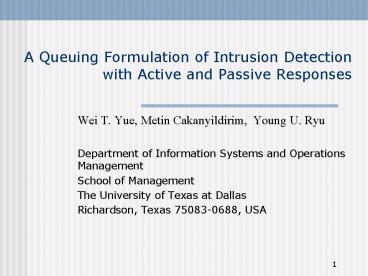A Queuing Formulation of Intrusion Detection with Active and Passive Responses - PowerPoint PPT Presentation
Title:
A Queuing Formulation of Intrusion Detection with Active and Passive Responses
Description:
IDS Quality: ROC curve ... Linear Piecewise ROC. 17. Optimal ... Extend the study with other types of ROC functions. Include multiple types of alarm ... – PowerPoint PPT presentation
Number of Views:31
Avg rating:3.0/5.0
Title: A Queuing Formulation of Intrusion Detection with Active and Passive Responses
1
A Queuing Formulation of Intrusion Detection with
Active and Passive Responses
- Wei T. Yue, Metin Cakanyildirim, Young U. Ryu
- Department of Information Systems and Operations
Management - School of Management
- The University of Texas at Dallas
- Richardson, Texas 75083-0688, USA
2
Introduction
- Traditional IDS response tends to be passive
passive response - Secondary investigation required because IDS is
still imperfect - Secondary investigation may not occur
instantaneously - These days, IDS can be set up to respond to
events automatically active response
3
Introduction
- Active response dropping connection,
reconfiguring networking devices (firewalls,
routers), additional intelligence mining
(honeypots) - We only consider terminating connection
4
Introduction
- In the intrusion detection process, IDS
configuration decision and the alarm
investigation decision are related - Alarm investigation resource would affect the
delays in response in both active and passive
response - If multiple alarm types involved, which alarm to
investigate is an issue
5
Research Goals
- Finding the corresponding configuration and
investigation decision for the active and passive
response approach - Determine the switching policy on intrusion
response
6
Problem Description
- Passive response
- potential damage cost - resulting from alarmed
events not investigated immediately - low false alarm costs since alarmed events are
not disrupted
7
Problem Description
- Active response
- It could prevent attack damage because the events
are terminated immediately - higher false alarm costs contingent on the
performance of the IDS
8
Problem Description
- Active response false alarm cost is related to
delay - Passive response damage cost is related
to delay
9
Problem Description
- Undetected, or non-alarmed intrusive events are
assumed to be the same for the two response
approach - Given the parameter values, the decisions
involved with the active and passive response
approaches are different
10
IDS Quality ROC curve
- A representation of IDS quality detection rates
(W(PF)) and false alarm rate (PF) - IDS quality can be determined experimentally
MIT Lincoln Lab (Lippman et al 2000a 200b),
Columbia IDS group (Lee and Stolfo, 2000), etc
11
IDS Quality ROC curve
12
A Queuing Model of Intrusion Detection
- Benign and intrusive event arrivals Independent
Poisson process with rate lB and lI - N number of investigator
- µ - investigation rate
- E(W(PF,N)) 1/N µ-PF lB -W (PF) lI
13
A Queuing Model of Intrusion Detection Active
Response
14
A Queuing Model of Intrusion Detection Passive
Response
15
A Queuing Model of Intrusion Detection
- We rewrite the N in terms of slack service rate S
- S mN-PF lB-W(PF)lI
16
Linear Piecewise ROC
17
Optimal Configuration and Investigation
18
Hybrid Response
19
Hybrid Response
20
Conclusion
- Derive optimal intrusion detection decisions with
linear piecewise function - Extend the study with other types of ROC
functions - Include multiple types of alarm






























